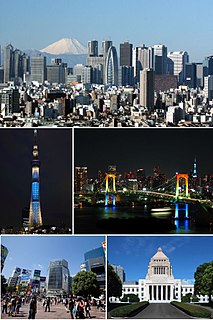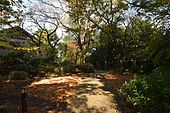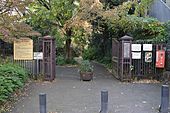
Shinjuku is a special ward in Tokyo, Japan. It is a major commercial and administrative centre, housing the northern half of the busiest railway station in the world and the Tokyo Metropolitan Government Building, the administration centre for the government of Tokyo. As of 2015, the ward has an estimated population of 337,556, and a population density of 18,517 people per km². The total area is 18.23 km². Since the end of the Second World War, Shinjuku has been a major secondary center of Tokyo (fukutoshin), rivaling to the original city center in Marunouchi and Ginza.

Nakano is a special ward in Tokyo, Japan. The English translation of its Japanese self-designation is Nakano City.

Meguro is a special ward in Tokyo, Japan. The English translation of its Japanese self-designation is Meguro City. The ward was founded on March 15, 1947.

Ikebukuro is a commercial and entertainment district in Toshima, Tokyo, Japan. Toshima ward offices, Ikebukuro station, and several shops, restaurants, and enormous department stores are located within city limits.

Ueno Park is a spacious public park in the Ueno district of Taitō, Tokyo, Japan. The park was established in 1873 on lands formerly belonging to the temple of Kan'ei-ji. Amongst the country's first public parks, it was founded following the western example as part of the borrowing and assimilation of international practices that characterizes the early Meiji period. The home of a number of major museums, Ueno Park is also celebrated in spring for its cherry blossoms and hanami. In recent times the park and its attractions have drawn over ten million visitors a year, making it Japan's most popular city park.

Mejiro Station, is a railway station on the Yamanote Line in Toshima, Tokyo, Japan, operated by the East Japan Railway Company.

Mori is a town located in Oshima Subprefecture, Hokkaido, Japan.

Inokashira Park straddles Musashino and Mitaka in western Tokyo, Japan. Inokashira Pond (井の頭池) and the Kanda River water source, established during the Edo period, are the primary sources of the Kanda River.

Not to be confused with Yumeshima, an artificial island in Osaka Bay
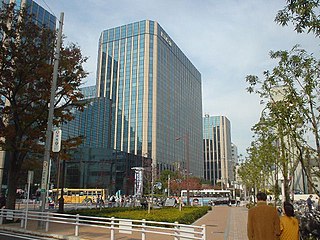
Ōmori (大森) is a district located a few kilometres south of Shinagawa, Tokyo, Japan accessed by rail via the Keihin Tohoku line, or by road via Dai Ichi Keihin. Ōmorikaigan, the eastern area of Ōmori, can be reached via the Keikyu line.

Shakujii Park is a public park in the Japanese town of Shakujii, in Tokyo's Nerima ward. Established in 1959, it is one of the larger parks in the metropolis, after Ueno Park. As of April 2006, the site is managed directly by the Tokyo Metropolitan Park Association, an arrangement which ended in March 2011.
Taiji Arita was a Japanese commercial photographer who exhibited non-commercial nudes and other work, and later a painter and sculptor.

Ochiai-minami-nagasaki Station is a railway station located at the Nishi-Ochiai itchōme intersection of Mejiro Dōri, Shin-Mejiro Dōri and Shin-Ōme-Kaidō in Shinjuku, Tokyo, Japan. This station is served by the Toei Ōedo Line. The Station number is E-33.
Agariyashiki (上り屋敷) is an area in Nishi-Ikebukuro 2-chōme and 3-chōme, Toshima, Tokyo, Japan, mainly along Seibu Ikebukuro Line. This term is commonly used, but has never been used as an official district name.
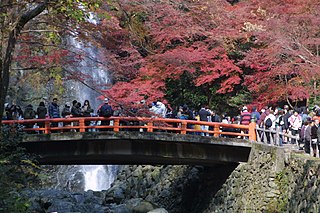
Meiji no Mori Minō Kokutei Kōen (明治の森箕面国定公園) is a Quasi-National Park in Osaka Prefecture, Japan. It was founded on 11 December 1967 and has an area of 9.6 km².
Mori Hamada & Matsumoto is one of the "Big Four" law firms in Japan.

Egota-no-Mori Park is a public park in Nakano Ward, Tokyo, Japan. It is the largest park in Nakano Ward.

Minami-Nagasaki Sports Park is a public park in Toshima Ward, Tokyo, Japan. It is the largest public park in Toshima Ward. The total park area includes the area of the Minami-Nagasaki Sports Center building and the football pitch. The area of the grassy section of the park excluding the football pitch is about 3,204 m2.

Izumi no Mori is a park in Yamato, Kanagawa Prefecture, Japan. The springs in the park are the source of the Hikiji River that flows into Sagami Bay.

